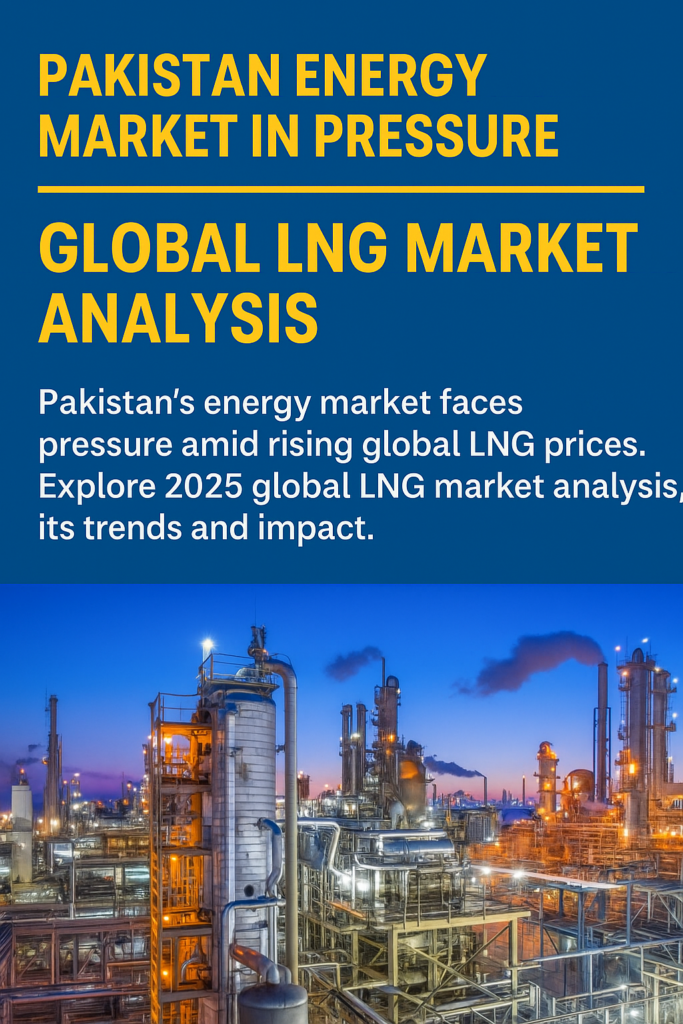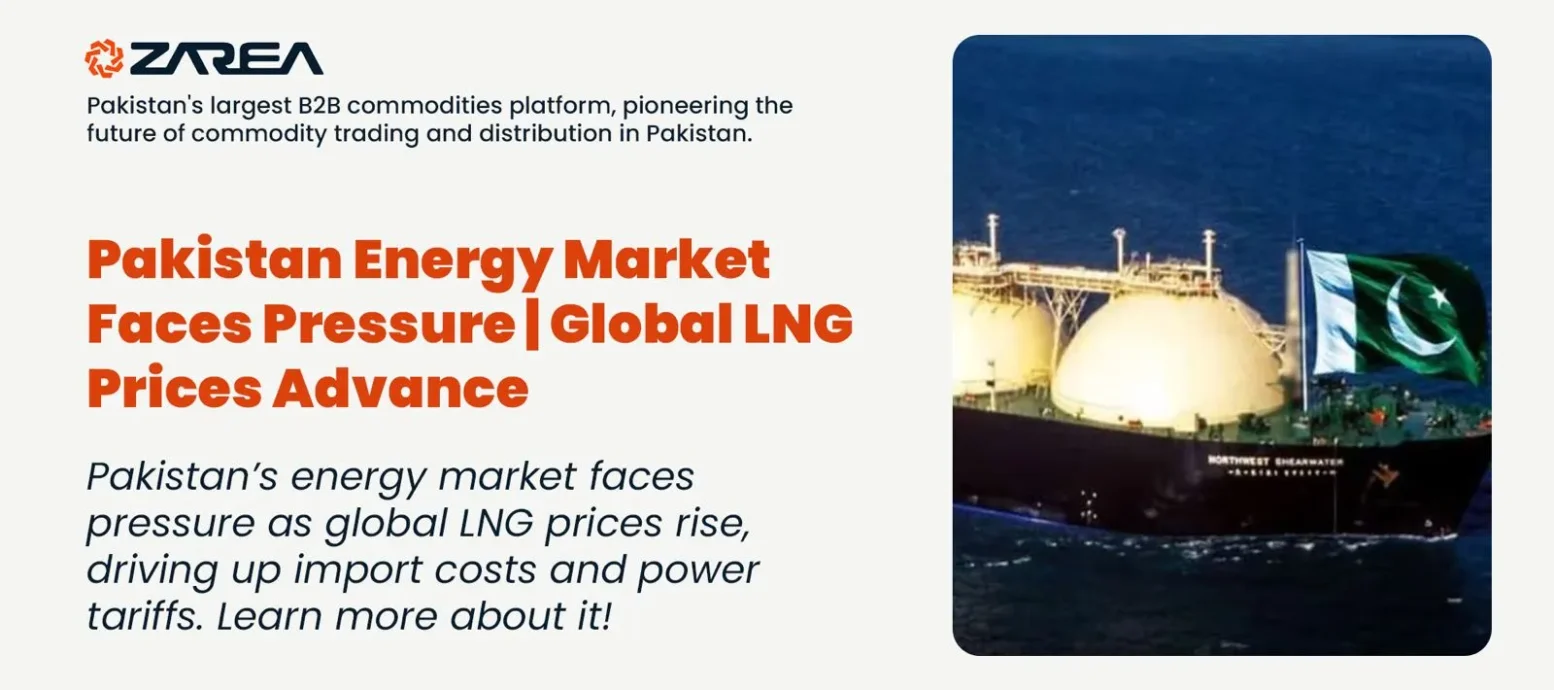Introduction – Global LNG Market Analysis:
Growing local demand, unstable supply chains and rising global liquefied natural gas (LNG) costs are under discussion these days. These factors have already put Pakistan’s energy sector in a precarious condition and under more strain. Meanwhile global markets are adapting to changing geopolitical and economic conditions the same as Pakistan’s. Moreover many other developing countries must navigate a more hybrid energy environment to survive.
In this article we provide a thorough examination of the worldwide LNG industry. We will also describe the implications for Pakistan’s energy security with an emphasis on major global trends. Furthermore, we will explain sustainable energy management and their future directions.
Overview – The State of Pakistan’s Energy Market:
For many years, Pakistan’s energy sector has faced fundamental difficulties, such as fuel shortages, cyclical debt, and postponed infrastructure projects. Pakistan’s dependence on imported energy, especially LNG, leaves it very susceptible to changes in the world’s gas markets.
The nation’s energy needs continue to exceed its potential for domestic generation in 2025. The demand for power is increasing by around 6–8% each year, but local gas supplies are running low. Pakistan imports LNG to close this deficit through spot market purchases and long-term contracts, both of which have grown more costly as a result of increased global competition.

Go to Zarea right now to see the biomass products and building materials, see the prices, and place your bulk purchase!
Global LNG Market Analysis – Key Trends in 2025:
According to a study of the global LNG industry, 2025 would be characterised by strong demand in Asia, tight supply circumstances, and ongoing disruptions brought on by geopolitical tensions. The market is volatile for a number of reasons:
Dynamics of Supply and Geopolitical Influences:
The continuing geopolitical conflicts including that of Middle East and Eastern Europe still shape worldwide LNG trade flows. Further, European countries are now actively securing LNG cargoes due to Russian gas supply interruptions to Europe. On the other hand, this situation has increased rivalries between Asian importers like Bangladesh, India and Pakistan.
Smaller economies have been forced to look for other energy arrangements as a result of the large increases in spot LNG costs, especially during seasonal peaks.
Growing Demand in Asia:
With more than 70% of all LNG imports, Asia continues to be the world’s largest LNG consumer. The market is still dominated by nations like China, Japan, South Korea, and India. However, mainly to fulfil their demands for electricity generation, Pakistan and Bangladesh have become important customers in South Asia.
Global LNG supply is now more limited due to increased demand in Asia, which has caused price instability and forced emerging countries to modify their procurement strategy.
Limited Ability to Provide New Supplies:
Although additional projects have been announced by major LNG producers including Qatar, the US, and Australia, the majority of them won’t be operational until 2026–2027. Due to this delay, short-term global supply growth is still limited, which keeps prices high and uncertainty high.
The Renewable Transition’s Role:
The world’s slow shift to renewable energy is another important element noted in the research of the global LNG industry. The demand for LNG has somewhat decreased in some areas as a result of many industrialised economies increasing their investments in solar, wind, and hydrogen. Nonetheless, LNG continues to be a vital bridging fuel for developing countries with less robust renewable infrastructure, particularly during periods of high demand.
Impact on Pakistan’s LNG Procurement and Power Sector:
The volatility of the global LNG market analysis directly affects Pakistan’s access to and price of energy. The nation finds it difficult to get spot cargoes at competitive pricing due to its inadequate foreign reserves. The production of power, industrial productivity, and family energy security have all been impacted by this problem.
Higher Import Prices:
Spot LNG prices have remained between $10 and $13 per MMBtu from midway through 2025 onwards. Further, these prices had already impacted Pakistan’s financially fragile economy. On the other hand, fiscal balances strain which result from the rupee’s devaluation versus the US dollar. These strains also drive up import prices.
Lack of Supplies and Shedding of Loads:
Periodic power outages and gas restrictions have resulted from uncertain LNG supply, especially during the summer when demand for electricity is at its highest.
reliance on long-term agreements:
Some stability has been provided by Pakistan’s long-term LNG supply agreements with QatarEnergy and other suppliers. Nevertheless, these contracts’ rigidity restricts the potential to profit from brief market declines.
Effects on Households and Industry:
Inflationary pressures have been exacerbated by rising energy costs, which have raised the cost of production for sectors, particularly textiles and fertilisers, while also raising utility bills for homeowners.
Pakistan’s Response to the Energy Challenge:
Pakistan is implementing a number of measures to diversify its energy mix and increase local resilience against global LNG market analysis shocks in order to solve these enduring problems.
Increasing Long-Term LNG Agreements:
The government has begun negotiating more long-term LNG agreements in order to lessen the dependency on erratic spot markets. But these contracts aid in order to maintaining steady supply and stabilising prices that usually last 10 to 15 years.
Development of Infrastructure:
There are currently investments being made in LNG terminals, storage facilities, and regasification capacity. The goals of projects in Gwadar and Karachi are to boost logistical effectiveness and handling capacity.
Encouraging the use of renewable energy:
According to Pakistan’s Alternative Energy Policy 2020, 30% of the energy would come from renewable sources by 2030. Solar and wind projects are top priorities in order to lessen the reliance on foreign energy. These future projects will be installed in the Sindh and Balochistan regions.
Exploration of Domestic Gas:
Incentives for exploration and production (E&P) firms to develop unexplored local gas fields have also been reinstated by the government. Over the next ten years, successful finds may help offset some of the nation’s LNG import requirements.
Demand management and energy efficiency:
Promoting industrial energy audits, smart grid technologies, and public awareness campaigns are among the main efforts in the energy market. These efforts are widely used to reduce waste and better control its usage.
Regional Perspective: South Asia’s LNG Dependency:
The state of the economy of Pakistan is similar to that of other South Asian nations. For industrial and power generating purposes, LNG imports are also crucial for Bangladesh, Sri Lanka, and India.
However, Pakistan’s capacity to compete for LNG cargoes is limited due to its severe economic constraints. On the other hand, Bangladesh has increased its infrastructure in order to import LNG. This initiative ensures a steady supply for its needs. Meanwhile India enjoys the advantages of a more varied energy mix and higher buying power.
This regional rivalry’s significance emphasises collaborative energy policies in order to maintain long-term stability and cross-border efforts. Furthermore, regional gas pipeline projects or shared LNG facilities are included in it.
Global LNG Market Outlook for 2026 and Beyond:
International energy analysts predict that when additional supply capacity from U.S. Gulf projects, African exporters, and Qatar’s North Field Expansion comes online, the global LNG market will gradually stabilise by 2026.
Although there will still be intense rivalry in Asia, the global LNG market research suggests that price volatility may decrease. This anticipated stabilisation might benefit Pakistan by reducing import prices and enhancing the dependability of energy planning.
Experts warn that Pakistan will continue to be vulnerable to international energy shocks. Until Pakistan makes substantial changes to its domestic policies. Moreover, continued investment in renewable energy sources and in energy diversity is necessary for long-term resilience.
Final Thoughts:
A combination of internal inefficiencies and demands from the global LNG market have left Pakistan’s energy system severely strained. According to the 2025 global LNG market estimate, Pakistan has had a direct influence on its capacity to obtain reasonably priced energy due to reasons such limited supply, increased demand from Asia, and increased price rivalry.
Although government efforts to increase contracts, improve infrastructure, and support renewable energy for a positive future. Yet they require long-term planning for sustainable solutions, regional collaboration and budgetary restraint.
Building a more independent, sustainable, and resilient energy future requires many crucial initiatives. Pakistan must have to strike a balance between short-term survival and long-term change in an era of global energy transition.

































